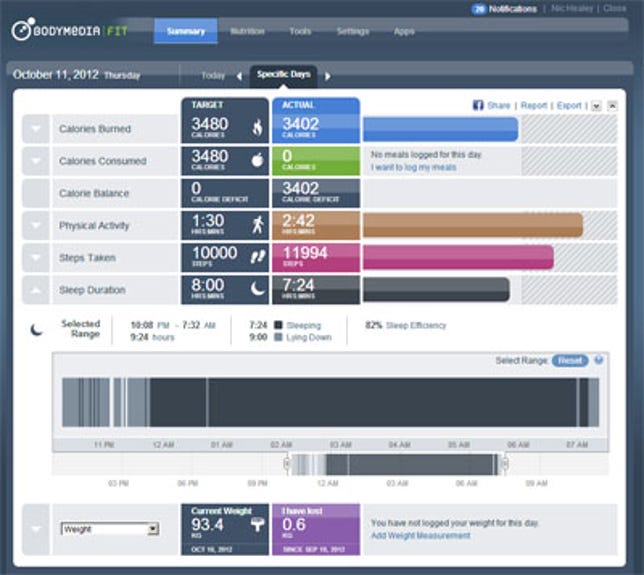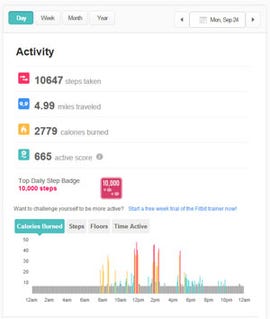Until recently, I had been training quite hard for a specific event — it was team-based and we were meeting two or three times a week to train together, in addition to other gym-based activities. It was all very fun in that “am I actually having fun, because I can’t tell, maybe my body has just developed a Stockholm Syndrome thing with muscle pain” kind of way. But one of the things I’d promised myself was that, when it was all finally over, I was determined to not just slump back into a lethargic mode. Hell no! I was fitter than I had been in ages and I was going to stay way. (I should say, at this point, that I was writing this while eating a jam doughnut).
Meet the competitors
So, with this in mind, I decided to put a couple of fitness monitors that are currently on the market to the test: the Fitbit Zip and the BodyMedia Fit. The original Fitbit Ultra was much lauded, and the company recently added two new models — the One (which will replace the Ultra — it’s AU$119.95 and is out in November) and the “starter model” Zip.
The Zip is lighter, cheaper (AU$69.95) and has a six month battery life, but has fewer features than the others in the same range. It counts steps for you (but not stairs) and estimates calorific loss based on the weight, height and age stats that you give it during set up. This is displayed on the tiny monochrome liquid crystal display, which you just tap to change between displays — there’s not a single button on it. It syncs via Bluetooth to a web-based dashboard (there’s even a tiny dongle in case your PC doesn’t have Bluetooth) and from the dash, you log additional info such as meals, other exercises and weight, as well as see a timeline of when you burned calories and when you were walking. This lets it build out a big picture of your activity and diet.
As competitor number one, I’m going to called it the Zipper.
In the other corner, we have BodyMedia Fit, and it’s a completely different beast (though, also AU$229). The Fit actually straps on to your upper arm — just around the left triceps. It’s chunky, but not uncomfortable, which is good, because you’re meant to wear it pretty much 24/7 — basically, any time you’re not submerged in water. From there, it uses either arcane voodoo or clever science to monitor steps taken, axis of motion (it can tell if you’re lying down), body temperature, galvanic skin response (your sweatiness, essentially) and even how much sleep you get.

 Enlarge Image
Enlarge ImageThe dash interface for the BodyMedia Fit (aka, The Strapper)
Screenshot/CNET
It also has a dash, which comes up when you sync the device by the slightly inconvenient process of pulling it out of its armband and plugging it via mini-USB (not micro). As an aside, can I recommend people set up the BodyMedia on their home PC? I’ve found that attempting to extricate a device from your left upper-arm under work clothes is tricky, and makes you look like a bit of an idiot in front of co-workers.
Its dash also lets you log food and weight, but also gives you an incredibly detailed view of your activity — not only how many steps you took, but when you were walking, when you slept, when — and how intense — your exercise was; the works. This almost makes up for the fact that there isn’t a display — although, there’s an optional clip on display that will sync up with it throughout the day and beep alarmingly when you meet your step or activity goals. It’s competitor number two, and in this fight, we’re nicknaming this The Strapper (something I’ll probably come to regret).
So, how do they perform? Well, the Zipper is definitely the most user friendly — clip it on and forget about it. Make sure you’ve synced up every now and then; plus log into the dash to add food and other exercise. It’s quite simple in theory. The Strapper, on the other hand, feels more demanding — I was wearing it 23.5 hours a day, taking it off only for shower time. It’s noticeable too: people will see it under shirt sleeves and ask about it all the time. In fact, it’s only at the gym or while running that people usually think it’s just an MP3 player and leave it alone.
Walk hard


In terms of accuracy, we will look at a single day — 24 September (mainly because it seems to have been a good day for exercise). According to the Zipper, I took 10,647 steps, while the Strapper says it was 10,835 — I’m happy to say that they’re basically the same number. The Strapper also reckons I did two hours and 11 minutes of activity, with a 27 minute block of “moderate” exercise occurring between 11am and midday. The Zipper backs this up — with a bit more detail, letting me know how many steps per every five minutes (in a tiny, tiny graph, admittedly). In all, the fact that they agree suggests that they’re both pretty accurate.
Stuff your face
Where they both have a little fail is in the American-centric nature of their food loggers. I like dumplings. I like a savoury breakfast. I like combining these two and having prawn dumplings when I can. Logging that was a little frustrating. From just typing in “dumplings”, the Zipper suggested I may have meant Chicken and Dumplings, canned (amongst other options). The Strapper also thought I may have meant canned chicken and dumplings, but also wondered if I’d meant baby food or “Chicken Thighs and Wings With Dumplings In Sauce”.
The issue is that, for a lot of the time, both of them want to know the (American) brand of what you ate. So if you say “I ate a Subway Italian Meatball on Rye”, they’ll say “cool, got that”. But if you say “I had a salad sandwich”, they’re all “did you mean the Arby’s Light Choice Low-Fat Turkey with Swiss and Salad”, at which point it’s easy to give up and stop logging food.
Which I did.
What else?
Well, I may have given up on my food diarising (for which I’m grateful), but I’m loving the exercise stuff. In fact, setting a goal like 10,000 steps (for the Zipper) or one and half hours of moderate or higher activity (for the Strapper) is a great way to just ensure that you’re up and moving — getting off your bum and heading out and about — and they’re both pretty darn excellent at that. In fact, the only reason I’m not still wearing both is because when I got home from a not-particularly vigorous jog around my local park, the Zipper was gone.
Just totally gone. It had somehow become unclipped from my shorts.
Now, I’ve asked around — there’s more than a few people I know who use the Zipper — and I may well be the first person in the history of the world who’s lost a Fitbit by having it fall off. I can only assume that it’s my fault, not any fundamental flaw on behalf of the Zipper’s design. I liked the Zipper — he had pluck. Moxy. He was in this fight, despite being a quarter of the size of the Strapper. He could have been a contender.
But now he’s gone, and I’m pretty sure I owe Fitbit’s PR people AU$70.
I’ve stopped wearing the Strapper now, too. And I’m off for more afternoon tea doughnuts. I think the moral of the story here is that the big loser in this fight is probably me.



